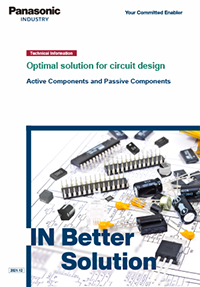Active Components and Passive Components
2021-12-10
When you hear about electronic devices for structuring an electronic circuit, you may think of electronic components such as transistors, capacitors, resistors, etc. These electronic devices are briefly divided into two groups, "active components" and "passive components."
Active components provide active influence such as amplifying, rectifying, or converting supplied electric energy.
On the other hand, passive components provide passive functions such as consuming, storing, or releasing supplied electric energy.
This article describes the outline of active components and passive components, along with their typical electronic devices and their features.
Classification of electronic devices
What are active components?
Active components are semiconductor devices consisting of semiconductor materials. Typical electronic devices are diodes and transistors, for performing "active" operations such as amplifying, rectifying, or converting supplied current (signal).
Semiconductors are substances (silicon, germanium and their compound, etc.) having a resistance rate somewhere between a conductor (iron, copper, gold, silver, etc.) and an insulator (rubber, ceramic, etc.). Semiconductor devices can be classified into single-function discrete (diode, transistor), optical semiconductors such as light-emitting devices (LED, laser) and light-receiving devices (photodiode, image pickup element), sensors capable of detecting temperature, pressure, acceleration, magnetism, and integrated circuit (IC) loaded with multiple functions. This article describes diodes and transistors as the most basic element and integrated circuits (ICs), which have become more important in recent years.
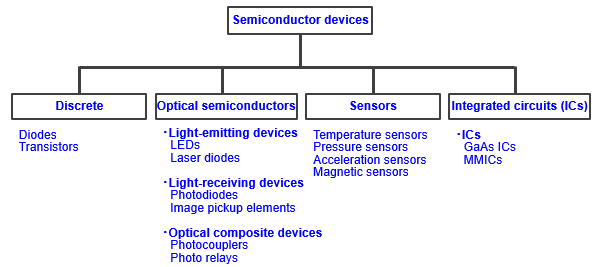
Diodes
Diodes are a component capable of passing electric current in one direction but stopping current in the opposite direction (rectifying characteristics) by joining combined semiconductors of type-p and type-n, and two types of materials such as semiconductor and metal. LED (light-emitting diode) is also a type of diode, which is known for emitting light, but has the same characteristic of passing current only in one direction. In addition, when the reverse direction current applied to the diode exceeds a certain voltage, it allows current flow, but even by increasing the current, the voltage does not change due to its unique nature (Zener phenomenon).
By utilizing these natures, a rectifier circuit is designed for taking out one-direction (forward direction) voltage only, or a detector circuit for taking out voice components alone from radio waves using the same principle, or for voltage control to maintain DC voltage at a constant value.
Transistors
Transistors are semiconductor devices made by joining p-type and n-type semiconductors one after another having three terminals called base (B), collector (C), and emitter (E).
Of the three terminals, when a small current is applied between the base-emitter, a much larger current flows between the collector-emitter as an amplifying function, and by similar principle, a change of current between the base-emitter causes a large change of current between the collector-emitter as switching nature, thereby providing two functions.
The range of transistor applications to circuit design is very wide, such as an amplifier circuit by utilizing the characteristics shown above, or switching circuit, a constant voltage circuit by suppressing power voltage fluctuation, and a logic circuit by utilizing input and output voltages for logical operation.
Integrated circuit (IC)
Integrated circuit (IC) utilizes semiconductor processing technology called photolithography to form multiple electronic components on a circuit substrate such as minute transistors and diodes on a semiconductor wafer. Types of ICs are largely grouped into digital ICs for handling digital signals, and analog ICs for handling analog signals. These components assume a central control function of electronic equipment such as complex data computation, conversion process, and data memory.
The evolution of micro-processing technology of IC has allowed for high functionality of electronic equipment such as high-speed and high-volume data processing, and equipment compact-sizing. In pace with technological evolution, a higher level of demand is applied to the peripheral electronic components for higher accuracy control, higher reliability, compact-sizing, etc.
What are passive components?
Passive components are fundamentally and essentially required electronic devices that perform "passive" operations such as consuming, storing, or releasing supplied electric power. Typical passive components are resistors, capacitors, coils, etc.
Resistors: R
Resistors perform functions of maintaining or changing electric current that flows in the circuit by consuming supplied electric power.
Imagine a simple circuit consisting of a power supply and a resistor. While keeping the power supply as it is, when the resistor value is increased, then the current in the circuit gets smaller, and when decreasing the resistor value, the current gets larger. As learned from Ohm’s law, it is an easy-to-understand example.
In actual circuit design, resistors are used for suppressing current so as not to allow more flow than the rated value into other components, or for obtaining the required current or voltage by dividing voltage or current flow, or for measuring the flow in the circuit.
*If you want to know more details, refer to the following article
・Basic Knowledge of Resistors - The roles, unit and symbol, standards -
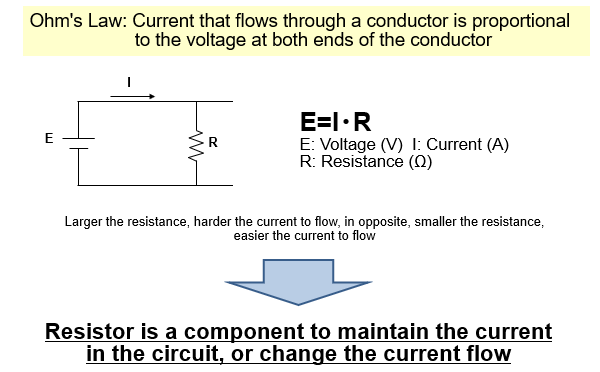
Capacitors: C
Capacitors are passive components for storing or releasing supplied electrical power (electrical charge), by blocking DC while passing AC, in particular, passing high-frequency current very well.
When DC is applied to a capacitor, it stores electrical charge to a maximum level, then stops the current flow. When AC is applied, the capacitor stores and releases electrical charge every time the current flow direction changes, so we can assume that AC practically flows through the capacitor. How much electrical charge can be stored in a capacitor is called capacitance. The higher the capacitance or higher the frequency of AC, the more current flows through.
In a circuit design, capacitors are used in an electrical discharge circuit for generating large currents by releasing stored power at once, or smoothing the circuit for stabilization by absorbing voltage fluctuation, or for coupling circuit by shutting off DC component from DC/AC composite current and taking out AC (signal) component, or for the opposite function of a de-coupling circuit by shutting off AC (noise) component.
*If you want to know more details, refer to the following article
・Basic Knowledge of Capacitors (1) - Mechanism, basic use, characteristics -
・Basic Knowledge of Capacitors (2) - Types, features, application -
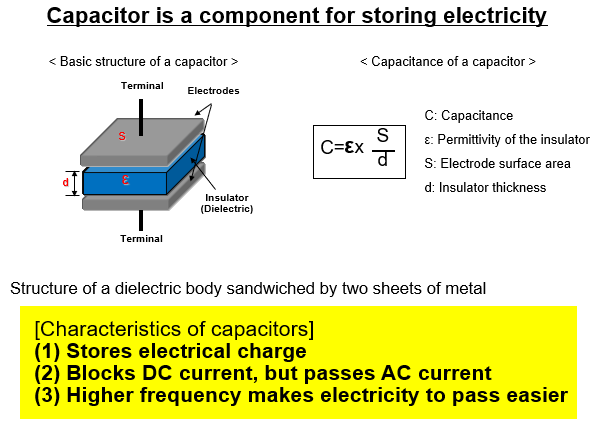
Inductors (Coil): L
A coil's function is to convert electricity (current) into a magnetic field or convert a magnetic field into a current. Coils pass DC as it is, but shuts off AC, and it becomes difficult to pass current when the frequency gets higher. Behavior toward DC and AC is opposite from capacitors.
Applying electrical current to wiring generates a magnetic field, but coils can store electrical energy as magnetic field through their winding structure of coil. DC passes through a coil as with a conductor, but AC generates a largely changing magnetic field by changes in current, and the self-induction of a coil generates a function similar to a resistor by that self-induction.
In circuit design, inductors are used in combination with an on-off capable switching element to obtain voltage suited for a specific purpose from the supplied power source to produce voltage-raising or lowering circuit, or used for low-pass/high-pass filter by taking out target frequency component alone from mixed-frequency AC by combining with capacitors, which have opposite property.
*If you want to know more details, refer to the following article
・Basic Knowledge of Inductors (coils) (1) - Basic structure, symbol, voltage and current -
・Basic Knowledge of Inductors (coils) (2) - Characteristics, types -
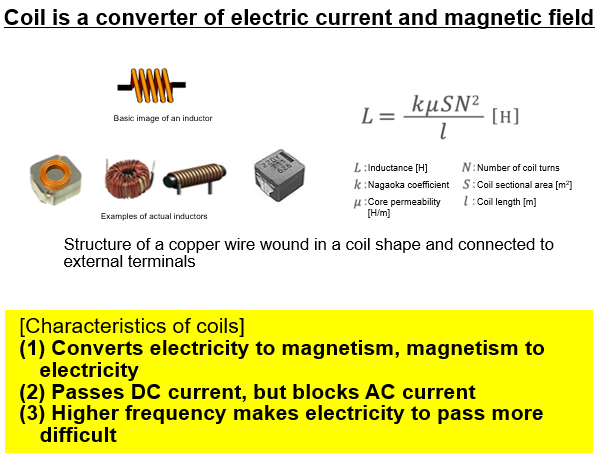
Electronic devices largely contributing to social progress
Electronic technology has evolved from old-time radios and TVs to AIs and big data, electric automobiles, auto-driving, robotics, etc., in recent years, at a speed not seen in other fields.
Supporting this evolution is a wide variety of electronic devices such as active and passive components loaded on circuit boards.
With the insatiable evolution of electronic equipment and automobiles, we expect further demands for electronic devices with high performance, compact sizing, heat resistance, long life, and reliability.
Our company lines up high-performance, compact lightweight, high-reliability products primarily with passive components by focusing on the evolution of electronic equipment and automobiles for our customers’ equipment designs.

